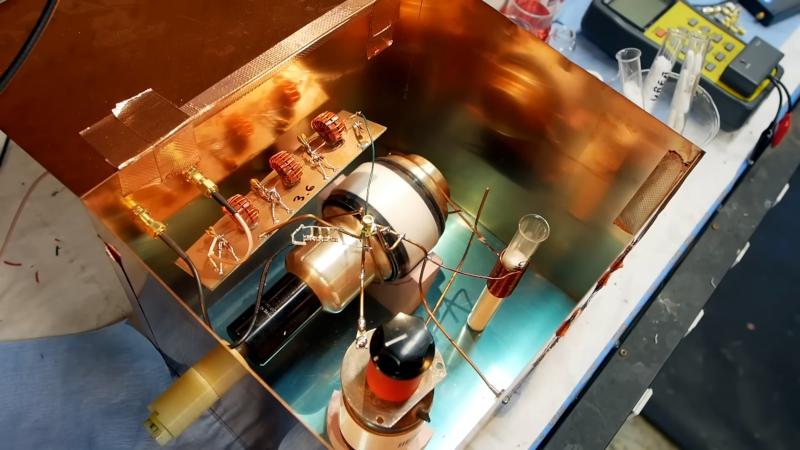Spectrometry is a well-known technique or, more correctly, a set of techniques. We usually think of it as the analysis of light to determine what chemicals are producing it. For example, you can tell what elements are in a star or an incandescent based on the spectrum of light they emit. But you can also do spectroscopy with other ranges of electromagnetic radiation. [Applied Science] shows how to make an RF spectroscope. You can see the video below.
An oscilloscope-resident function generator creates a signal that he feeds to an amplifier because you need a fair amount of power going out. However, you also need to sense a very tiny amount of power coming back, and that requires a special circuit that will block high-power signals while passing low-level signals.
Because of the low level of signals involved, you do need some special RF techniques. You also need a way to read back the spectrum. Turns out a NanoVNA works fine for this application. The actual science behind this is the same idea as what happens with nuclear resonance imaging. The end of the video has a detailed explanation of what makes it work.
Of course, this machine doesn’t do the image part. But we’ve seen an attempt to do just that, too. There are many different kinds of spectroscopes. There are ones that use a laser and Raman scattering, and some that just light things up with a laser.
















Preempting the semantic argument re: spectrometry vs. spectroscopy…
But in any case, it’s a very crude but functional NMR. It’s quite impressive that you can assemble something like one on a benchtop with modern day equipment.
It was published in Scientific American, and hence it’s in C.L. Strong’s “Amateur Scientist” (using tube amplifiers). According to that article, this was first done right after WWII, but I can’t find when the original article was published.
The typical problem with these setups is that the response frequency is strongly dependent on the strength of the magnetic field, so if the field isn’t perfectly uniform the variations (from one end of the coil to the other) generate a range of frequencies. The peak becomes spread out and deciphering multiple peaks becomes progressively more difficult.
This is why medical NMR setups are so large – you are put into the middle, where the field is more uniform.
His setup might benefit from a smaller sample held in the middle of the coil.
I’ve often wondered if it isn’t possible to compensate for the non-uniform aspects of the field by adding more wraps at either end – making the field more uniform in the middle at the expense of having the field diverge more wildly outside the coil. Or using extra coils at each end with computer controlled feedback, essentially “sculpting” the magnetic field.
Perhaps a Helmholtz coil ?
https://en.m.wikipedia.org/wiki/Helmholtz_coil
This is using NQR, which happens at zero field.
For other applications, you can also use Earth’s field NMR, which is pretty uniform. The downside is that a low field gives a small signal.
> Turns out a NanoVNA works fine for this application.
NanoVNA is used only for tuning the RF circuit. Actual readout is done with an oscilloscope and FFT.
Wow! Desktop MRI. Very cool!
Actually desktop NQR. Still very cool! That especially because the nuclear quadrupole resonance does not need an external magnetic field to produce the signal. However, it only works on solids because it needs the electrical uneven electric field within the molecule. In liquids the molecules are moving all the time and randomize the orientation too fast. NMR works on both liquids and solids and liquids are often easier. Because the two techniques depend on different imbalances of spin within the nuclei, they work on different elements and many elements don’t respond to either one.
Tabletop NMR is certainly also possible by using high intensity permanent magnets. https://doi.org/10.1002/cmr.b.10082 talks about a magnet design with that in mind. The RF pulse and detector coil would be similar those shown in the video. The problem for NMR is that in order to get spectra with sufficient resolution to distinguish different chemicals, the magnetic field has to be very very smooth across the sample and that takes some additional hacks.